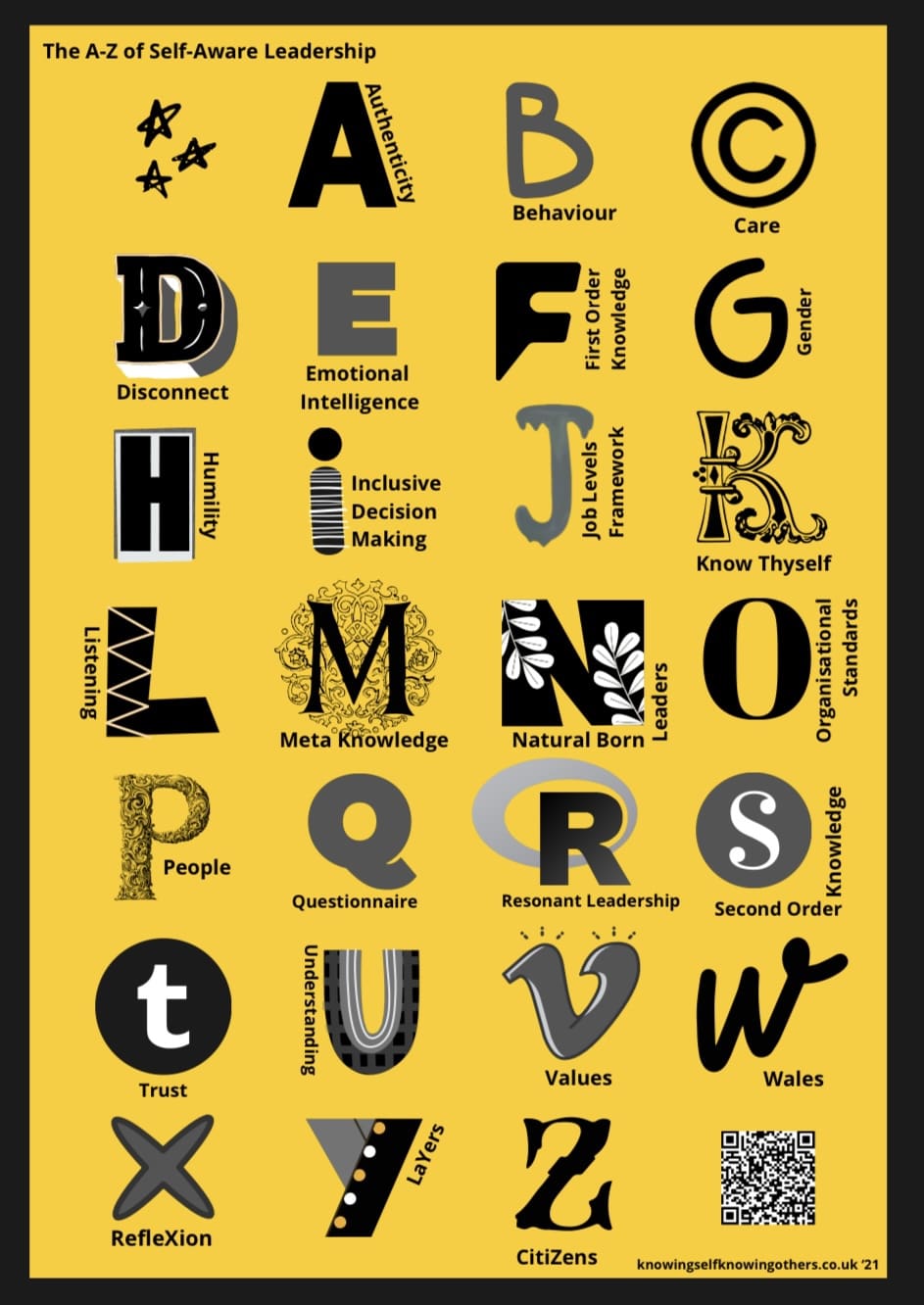
A is for Authenticity
To be an effective leader we need to behave in an authentic way and to be authentic, we need to know what we think and feel about our values and strengths
B is for Behaviour
When we are self-aware, we are aware of our behaviour, how others view our behaviour and how we can regulate our behaviour to change others’ responses to us
C is for Care
Leadership is about care for those we lead and consideration about how our behaviour and decisions impact them
D is for Disconnect
My research found that there is a disconnect between people at the strategic level of organisations and others. By being more self aware, we can help reduce this gap.
E is for Emotional intelligence
Emotional intelligence is often used as a proxy for self-awareness. The literature either takes the stance that self-awareness is an element of emotional intelligence, or emotional intelligence is an element of self-awareness.
F is for First Order Knowledge
Technical knowledge and capabilities are referred to as first order knowledge, or hard skills. They’re technical skills that are generally thought of as being able to be taught, like the process to follow to induct someone into an organisation or how to place an order in the procurement system
G is for Gender
More women than men responded to my questionnaire. About 17% more women responded than expected. Because of that, I carried out a number of interviews with men to make sure I had a balance of voices in my study.
H is for Humility
People who are self-aware generally rate themselves as having less self-awareness and being less effective leaders than how they are rated by other people. Self-aware people are generally more humble than people who aren’t self-aware
I is for Inclusive decision making
My study found that one way to narrow the gap of disconnect between people working at the strategic level of the organisation was to include everybody in decision making
J is for Job Level Framework
My study was interested in leadership at all levels. As a way of making sure people from across all of the Welsh public service organisations could be included in my study, I developed the Five Functions Job Level Framework. It’s made up of operational, business, management, senior management and strategic job levels that can apply to all Welsh public service organisations.
K is for Know Thyself
The idea of self-awareness has been around since before the time of Socrates in 300BC. The words ‘know thyself’ are carved in stone at the Temple of Delphi. An Essay on Man by Alexander Pope reads, ‘Know then thyself, presume not God to scan: The proper study of mankind is man’.
L is for Listening
To be self-aware, we need to listen to what people around us are saying and how they are responding to us. Reflecting and listening to others helps us build a picture of how we are viewed by others
M is for Meta Knowledge
Meta knowledge is an awareness of the self. If we acknowledge ourselves as sentient beings, we are said to have meta cognition. Knowledge of what we know and what we don’t know is referred to as meta knowledge
N is for Natural born leaders
People who responded to my study felt that training had limited ability to make individuals into leaders. To lead, individual must have an innate ability which can be enhanced and developed through learning and training.
O is for Organisational standards
My study found that people felt many organisations recognise and reward technical knowledge and skills over people skills. One of my recommendations is that organisational standards around self-awareness, emotions and behaviours need to be reviewed to take greater account of second order emotions and behaviours
P is for People
Self-awareness and leader effectiveness are socially constructed, meaning that they can only be generated when we are in relation with others. This means that leadership is all about having positive relationships with others. If we’re self-aware we’re better able to develop these relationships.
Q is for Questionnaire
I carried out a questionnaire that asked questions about gender, age, organisation, job level, self awareness and leader effectiveness of the respondent and their direct line manager
R is for Resonant Leadership
The model of leadership that fits best with exploration into self-awareness in the workplace, is resonant leadership. It’s based on the four elements of emotional intelligence: self-awareness, self-management, social awareness and relationship management.
S is for Second Order Knowledge
Emotions, behaviour and self-awareness are referred to as second order knowledge, or soft skills. They’re skills that can’t be taught, such as feeling sympathy for the person who has just lost their job or the want to nurture a graduate trainee, new to the organisation.
T is for Trust
To be an effective leader who receives honest and constructive feedback, there must be trust. The literature says that when leaders betray the trust of others they undermine the faith of colleagues in them as individuals as well as their organisations
U is about understanding
Self-awareness is all about understanding ourselves and understanding others. When we have a better understanding of ourselves and others, we have the ability to change ourselves, which is turn changes how people respond to us.
V is for Values
When leaders know their values, they can operate authentically in living within values. My study found that the standards of some organisations were at odds with the standards and values of individuals. Some organisations actively encourage promotion of people that are technically capable but have limited emotional intelligence, which is sees as detrimental to team development.
W is for Wales
I carried out my study on the Welsh public service. I’d love to see my study replicated across different countries and sectors.
X is for ReflXion
One of the main mechanisms for developing self-awareness is reflection. By reflecting on your own thoughts, feeling and behaviours and inviting reflection from others, you can develop a more rounded view of yourself and reduce your blind spots- the things you don’t know you don’t know. Feedback from other people is an essential component of self-awareness
Y is for LaYers
I’ve developed a 3 layer definition of self-awareness and leader effectiveness.
1. Internal self-awareness: an ability to recognise the self’s changing thoughts feelings, beliefs, values, strengths and abilities through reflection and introspection. This is linked with leader awareness of first order technical knowledge and capabilities and second order emotions and behaviours
2. Internal-social self-awareness: an ability to recognise how the self is viewed and perceived by others. This is linked with leader awareness of impact of first order technical knowledge and capabilities and second order emotions and behaviours
3. External-social self-awareness: an ability to read and understand the emotions and intentions of others, recognising the self’s impact on others and responding and acting wisely in social exchanges. This is linked with leader ability to regulate first order technical knowledge and capabilities and second order emotions and behaviours
Z is for CitiZens
Around 25% of the citizens of Wales are employed in the Welsh public service which means that community life and work life is very closely connected. It’s worth bearing in mind that what’s going on in the community might make things difficult in work. Managers may struggle to deal with tricky situations if they manage people from their community.

